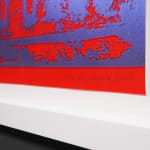





Mel Bochner
'Oh Well', 2020
Seven color silkscreen print
72 x 54 x 2 in.
182.9 x 137.2 x 5.1 cm.
182.9 x 137.2 x 5.1 cm.
Edition of 30
Edition of 30
Signed by the Artist.
Signed by the Artist.
Copyright The Artist
Further images
'Oh Well' is a seven color silkscreen print by contemporary artist, Mel Bochner. This piece was created in 2020 in a limited edition of only 30 prints in existence and...
'Oh Well' is a seven color silkscreen print by contemporary artist, Mel Bochner. This piece was created in 2020 in a limited edition of only 30 prints in existence and is signed by the Artist. The bold cherry red and iridescent powder blue is the quintessential pop-art color palette, a perfect juxtaposition of primary colors. Simple, layered, and assertive word play has become Bochner's instantly recognizable iconic motif. 'Oh Well' displays the Artist's signature loud graphic text with a rough around the edges appeal, creating an air of discreet communication directly with the viewer. 'Oh Well' is exceptionally grand in scale and comes ready to install with a custom made museum caliber frame and UV protective glass. The unframed dimensions measure approximately: 67 x 48 in. / 170 x 122 cm. The custom framed listed dimensions measure: 72 x 54 x 2 in. / 183 x 137 x 5 cm. Mel Bochner is recognized as one of the leading figures in the development of Conceptual art in New York in the 1960s and 1970s. Emerging at a time when painting was increasingly discussed as outmoded, Bochner became part of a new generation of artists which also included Eva Hesse, Donald Judd, and Robert Smithson - artists who, like Bochner, were looking at ways of breaking with Abstract Expressionism and traditional compositional devices. Bochner came of age during the second half of the 1960s, a moment of radical change both in society at large as well as in art. Bochner received a Bachelors of Fine Arts in 1962 and honorary Doctorate of Fine Arts in 2005 from the School of Art at Carnegie Mellon University. While painting slowly lost its preeminent position in modern art, language moved from talking about art to becoming part of art itself. Bochner has consistently probed the conventions of both painting and of language, the way we construct and understand them, and the way they relate to one another to make us more attentive to the unspoken codes that underpin our engagement with the world. His pioneering introduction of the use of language in the visual, led Harvard University art historian Benjamin Buchloh to describe his 1966 Working Drawings as “probably the first truly conceptual exhibition.”





